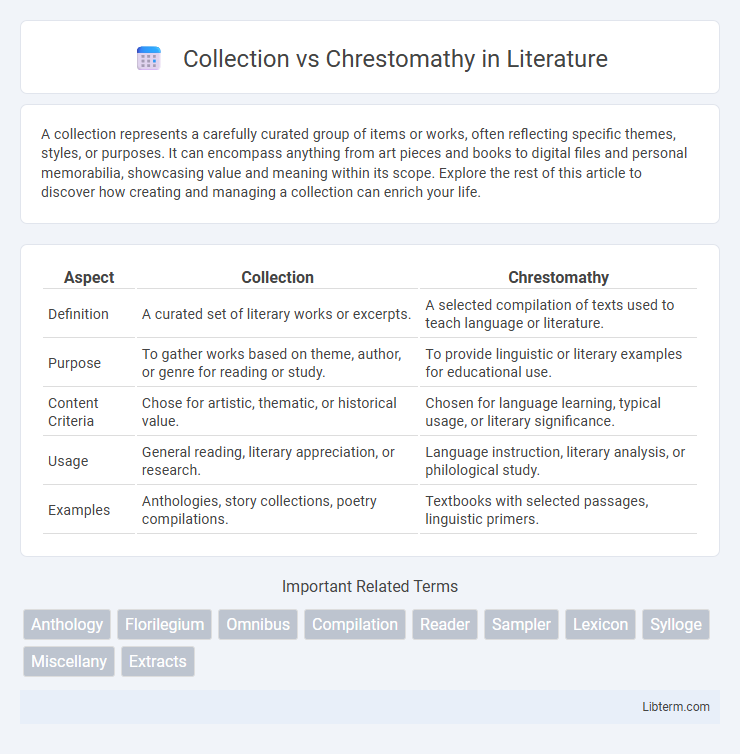A collection represents a carefully curated group of items or works, often reflecting specific themes, styles, or purposes. It can encompass anything from art pieces and books to digital files and personal memorabilia, showcasing value and meaning within its scope. Explore the rest of this article to discover how creating and managing a collection can enrich your life.
Table of Comparison
| Aspect | Collection | Chrestomathy |
|---|---|---|
| Definition | A curated set of literary works or excerpts. | A selected compilation of texts used to teach language or literature. |
| Purpose | To gather works based on theme, author, or genre for reading or study. | To provide linguistic or literary examples for educational use. |
| Content Criteria | Chose for artistic, thematic, or historical value. | Chosen for language learning, typical usage, or literary significance. |
| Usage | General reading, literary appreciation, or research. | Language instruction, literary analysis, or philological study. |
| Examples | Anthologies, story collections, poetry compilations. | Textbooks with selected passages, linguistic primers. |
Understanding the Concept of Collection
A collection refers to a systematically gathered set of items or data, often curated to serve a specific purpose or theme, enabling organized access and study. Unlike a chrestomathy, which is a selected anthology primarily intended for learning or illustrating language use, a collection emphasizes comprehensive aggregation rather than selective excerpts. Understanding a collection involves recognizing its role as a structured repository that supports research, preservation, or thematic exploration.
Defining Chrestomathy: Origins and Usage
Chrestomathy originates from the Greek word "chrestomathia," meaning "useful learning," and refers to a curated selection of literary passages designed for language study or literary analysis. Unlike a general collection, which may include varied and unrelated works, a chrestomathy specifically emphasizes educational or linguistic value by compiling exemplary texts that showcase style, vocabulary, or thematic elements. Its usage primarily supports language acquisition and scholarly research by presenting carefully chosen excerpts that reflect the linguistic and cultural characteristics of a particular language or literary period.
Key Differences Between a Collection and a Chrestomathy
A collection is a curated assembly of various items or texts, often grouped by a general theme or purpose, while a chrestomathy specifically consists of selected literary passages intended for learning or linguistic study. Collections tend to be broader and less structured, whereas chrestomathies focus on exemplary examples that illustrate language usage, style, or historical context. The primary difference lies in the educational aim of chrestomathies compared to the more general or aesthetic intent behind collections.
Purposes of Collections in Literature and Academia
Collections in literature and academia serve as curated assemblies of texts or artifacts designed for systematic study, preservation, and reference. Their primary purpose is to facilitate thematic exploration, comparative analysis, and comprehensive understanding of a particular subject or genre. Chrestomathies specifically aim to provide exemplary excerpts to aid language learning, cultural studies, and philological research by presenting a representative sample of linguistic or literary works.
The Role of Chrestomathies in Language Learning
Chrestomathies play a crucial role in language learning by providing curated selections of texts that highlight linguistic structures, vocabulary, and usage within authentic contexts. Unlike general collections, chrestomathies offer graded materials designed to progressively develop reading comprehension and cultural understanding. These focused compilations enable learners to engage with language in a structured manner, enhancing retention and facilitating effective language acquisition.
Selection Criteria: How Content is Chosen
Collection selection criteria emphasize thematic unity, relevance, and representativeness, ensuring each item reflects the overarching purpose or subject matter. Chrestomathy selection prioritizes educational value, focusing on exemplifying language, style, or usage patterns to aid learning and linguistic analysis. Content choice in a chrestomathy often involves selecting texts that showcase diverse linguistic features or historical language stages for instructional effectiveness.
Historical Examples of Famous Collections
Famous historical collections such as the Medici family's extensive art assemblage and the British Museum's vast cultural artifacts exemplify the concept of a collection, where items are curated for preservation and study. In contrast, chrestomathies like Anne Kilpatrick's "Classical Samplers" compile literary excerpts or texts for educational purposes, emphasizing language acquisition and comprehension. These examples highlight collections as comprehensive repositories of tangible objects, while chrestomathies function primarily as curated text anthologies designed for learning.
Renowned Chrestomathies Throughout History
Renowned chrestomathies throughout history, such as Friedrich Nietzsche's *Chrestomathie der neuen Werke* and Thomas Arnold's *Chrestomathiae Graecae*, serve as curated collections designed to teach language or literature by showcasing exemplary texts. Unlike general collections, chrestomathies emphasize didactic selection to provide linguistic, cultural, or literary insights, often facilitating scholarly study and language acquisition. These works have shaped educational curricula by offering structured access to canonical texts across classical, medieval, and modern periods.
Practical Applications in Modern Education
Collections organize diverse texts or artifacts to support thematic learning, enabling students to compare and analyze materials across subjects efficiently. Chrestomathies curate selected excerpts specifically designed to illustrate linguistic, literary, or historical principles, making them ideal for targeted language acquisition and specialized study. Modern educational practices leverage collections for broad interdisciplinary engagement, while chrestomathies enhance focused skill development and contextual understanding in curriculum design.
Choosing the Right Approach: Collection or Chrestomathy
Selecting between a collection and a chrestomathy depends on the purpose of the text compilation; collections prioritize thematic or authorial coherence, whereas chrestomathies emphasize learning through curated excerpts showcasing linguistic or stylistic variations. Collections are ideal for readers seeking comprehensive access to related works, while chrestomathies serve educational goals by providing annotated samples that highlight language usage or literary techniques. Understanding the target audience and the intended educational or research outcomes guides the decision towards either assembling a broad collection or a focused, instructional chrestomathy.
Collection Infographic

 libterm.com
libterm.com